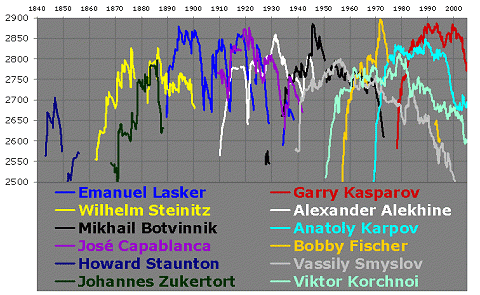Here is another graph, showing the succession of strongest players.
Interestingly, it begins with Howard Staunton, omits Adolf Anderssen and Morphy, includes Victor Korchnoi(!), but does not include Mikhai Tal or Tigran Petrosian. (From chessbase.com, 2010)
These data present "performance ratings." Fischer's peak at 2895.

Based on the seminal work by Professor Arpad Elo, the inventor of the Elo Rating System, I will open this discussion with a list of players who, from 1855 to 1975, rated as the strongest player in the world.
These data come from Prof. Elo's book, and particularly his graphs and tables. The main graph ("Lifetime Ratings, Selected Grandmasters" Pages 88-89), which is partially reproduced on the dustcover of the hardback version of his book, provides the following information. To obtain "Elo Ratings" for masters who pre-dated their invention, Prof Elo meticulously back-calculated tournament and match results. After publication, the database was found to have some errors, however, they were not serious enough to compromise the entirety of his work.
Adolph Anderssen of Prussian Silesia won the famous London (knockout) Tournament of 1851. Elo's estimate of Anderssen's rating, normalized to 1975, was approximately 2595 (these are estimates from reading the graph).
1855-1858, 2600 (peak), A. Anderssen
1858, 2690 (peak), P. Morphy
1859-1866, A. Anderssen
1866-1891, 2650 (peak), W. Steinitz
1891-1914, 2720 (peak), E. Lasker
1914-1927, 2730 (peak), J. R. Capablanca
1927-1942, 2685 (peak), A. Alekhine
1942-1954, 2730 (peak), M. Botvinnik
1954-1961, 2700 (peak), V. Smyslov
1961-1963, 2680 (peak), T. Petrosian
1963-1975, 2780 (peak), R. Fischer
Notably missing from Elo's "selected grandmasters" are M. Tal and B. Spassky. The exclusion of Tal (best 5-year average = 2700) is understandable given his health problems and erratic results, though I would suggest he was the top dog in 1959-61. Why Spassky (best 5-year average = 2680) was left out is anyone's guess, other than he may never have been the strongest player in the world, given Fischer's rating after 1963.
Fischer's curve is the most anomalous of all. His rise was meteoric, and showed no decline. Other's curves were, at times affects by layoffs due to wars, etc.